Gazelle
Gazella gazella
Named for the Arabic word for love poems
Advertisement
Gazelle Scientific Classification
- Kingdom
- Animalia
- Phylum
- Chordata
- Class
- Mammalia
- Order
- Artiodactyla
- Family
- Bovidae
- Genus
- Gazella
- Scientific Name
- Gazella gazella
Read our Complete Guide to Classification of Animals.
Gazelle Conservation Status
Gazelle Facts
- Name Of Young
- fawns
- Group Behavior
- Herd
- Fun Fact
- Named for the Arabic word for love poems
- Estimated Population Size
- <500
- Biggest Threat
- hunting
- Most Distinctive Feature
- Long curved horns
- Gestation Period
- 5-6 months
- Litter Size
- 1-2
- Habitat
- Grasslands, savannas, shrubby steppes
- Predators
- Lions, leopards, cheetahs, hyenas, wolves
- Diet
- Herbivore
- Type
- mammal
- Common Name
- gazelle
- Number Of Species
- 16
- Location
- Africa, Asia
- Group
- herd
Gazelle Physical Characteristics
- Color
- Brown
- Yellow
- Black
- White
- Skin Type
- Fur
- Top Speed
- 60 mph
- Lifespan
- 10-12 years
- Weight
- 26 to 165 lbs.
- Height
- 2.0 to 3.6 feet
- Length
- 42.0 to 49.0 feet
- Age of Sexual Maturity
- 1 year (males) to 1.5 years (females)
- Age of Weaning
- 2-3 months
View all of the Gazelle images!
“The name for a gazelle comes from the Arabic word for a love poem.”
The gazelle is a graceful, intelligent, and alert creature. Though they once were in the thousands in Africa and Asia, this beautiful beast now only has a few hundred left in their family as the result of hunting. At great speeds, it can’t quite outrun predators but the way they jump helps them to get away. Though challenged in number, you can still see just under 500 in the wild today.
4 Incredible Gazelle Facts!
Here are a few fun facts about gazelle animals:
- Gazelles are not fast enough to evade the path of a cheetah, but they are able to outmaneuver them as they run away.
- Males and females have horns, unlike many mammals in the antelope family.
- When a gazelle is nervous, he or she will honk.
- A gazelle can jump 10 feet in the air and can run up to speeds of 60 mph in short bursts.
Scientific name
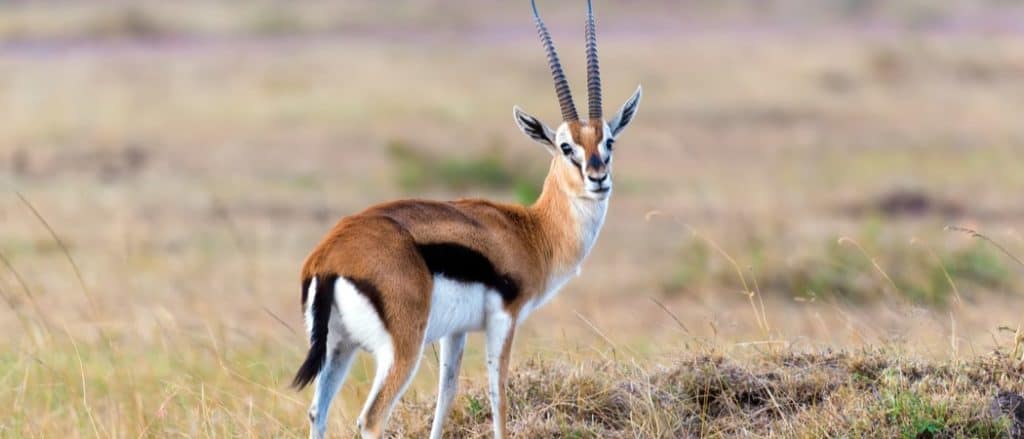
Gazelles are classified as bovids making them relatives of cows, goats, and sheep
©Volodymyr Burdiak/Shutterstock.com
The scientific name of the gazelle (which is this mammal’s common name) is gazella gazella. It belongs to the Bovidae family of the Mammalia class. This particular type of animal covers 17 different species, which include (but are not limited to) the:
- Thomson’s gazelle: These medium-sized gazelles which live in East Africa are capable of growing to 26 to 165 pounds in weight and 20 to 43 inches at the shoulder. They are capable of reaching speeds of 40 mph and may live in large herds numbering in the hundreds.
- Dama gazelle: Less than 400 members of this species which are commonly found in Chad and Sudan, exist in the wild. These large gazelles are capable of weighing about 88 to 190 pounds and reaching 40 inches at the shoulder.
- Dorcas gazelle: Found in the grasslands, plains, and deserts of Africa and the Middle East, these gazelles are capable of living their entire lives without drinking water. They are capable of measuring 55 – 65 cm at the shoulder and weighing 33–44 pounds.
- Grant’s gazelle: This rather corpulent gazelle which can be found in East Africa has a robust frame and a pale tan upper body coat. It is capable of reaching 35 inches at the shoulder and weighing 180 pounds.
- Speke’s gazelle: Once regarded as a subspecies of the Dorcas gazelle before being recognized as a species in its own right, this bovid is known for its pale coat. It can be found in the Horn of Africa.
The scientific name “gazella gazella” comes from the Arabic word ghazāl, which is from the word for a love poem.
Appearance
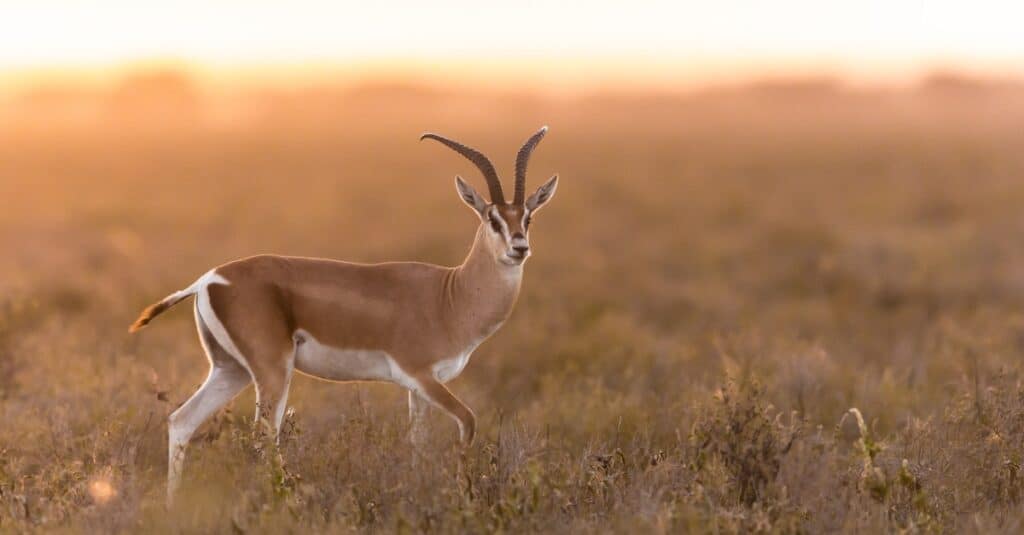
Female gazelles also have horns like their male counterparts
©iStock.com/StuPorts
Identification of a gazelle is rather easy if you look for the yellowish-brown coat with a white underbelly. As part of the antelope family, they have rather long horns that usually curve. Though other antelope species only have males with horns, the females also have them in this particular animal.
The size varies greatly between the different types of these animals. Ranging from two to 3.6 feet tall, they are quite short in comparison with other antelopes. While much of their reliance to conceal themselves is on speed, they also camouflage with the desert landscape with their brownish coloring. The specific markings in their coat allow the identification of different species.
Evolution
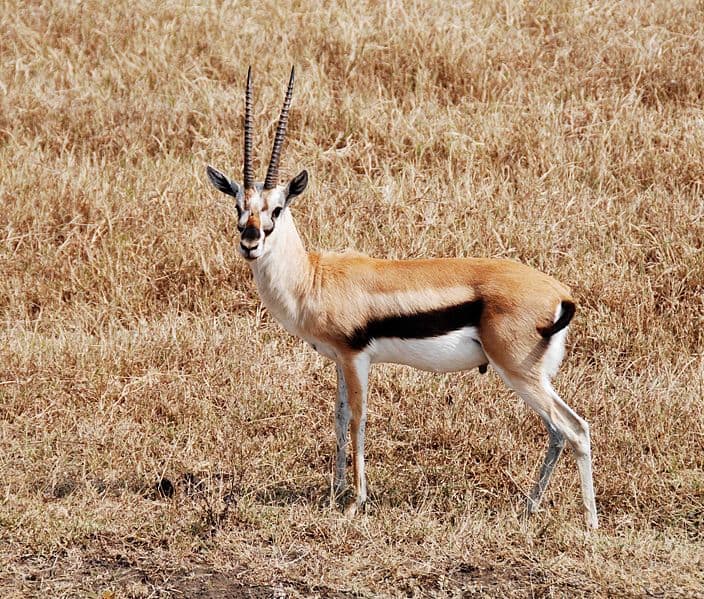
The ancestors of gazelles, appeared during the early Miocene
©The original uploader was Energo at Polish Wikipedia. / Creative Commons – Original / License
The evolutionary tale of gazelles goes way back to the early Miocene when bovids separated from deer and the ancestors of the giraffe.
These woodland mammals are believed to have been small in size and rather similar to present-day gazelles.
The earliest ancestors of gazelles, blackbucks, dibatags, gerenuks, and springboks, also known as Antilopines appeared on the scene during this same period, and fossils of these herbivores belonging to the middle Miocene have also been found.
By the middle and late Miocene, the family began to further subdivide into different species.
Behavior
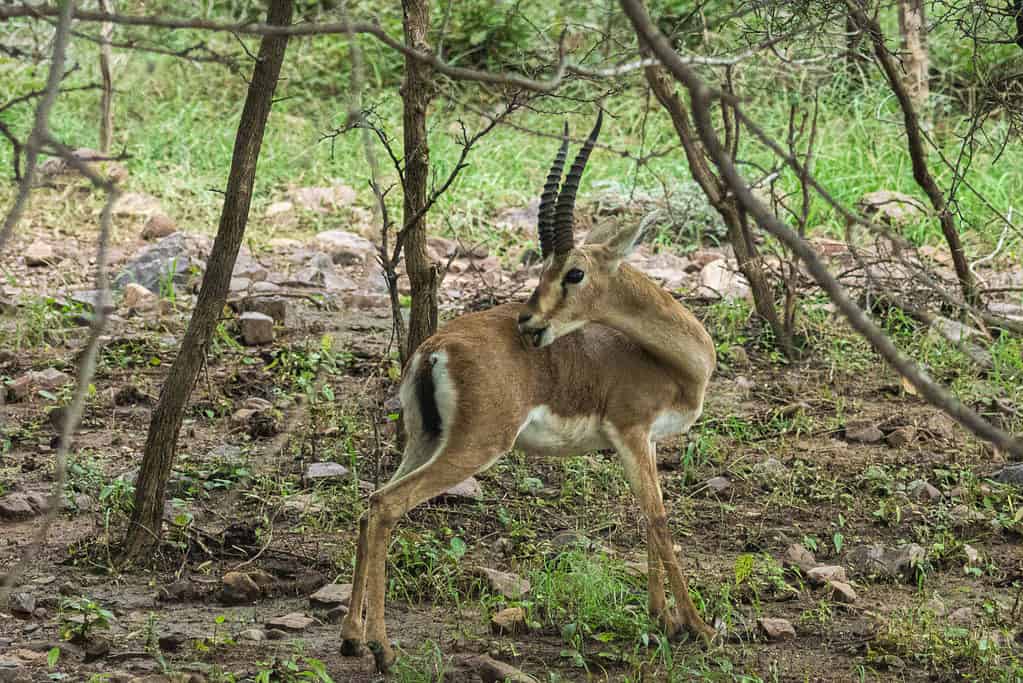
.Gazelles are social animals and may congregate in herds consisting of several hundreds of other individuals
©iStock.com/Ayushi Basak
Gazelles live within a group called a herd, which can be comprised of as many as 700 other gazelles. However, some herds are much smaller, including 10-30 females with their fawns. Most often, females and males do not live together in the same herd, as males tend to exclusively live in a small group or completely alone. Any herd that is only made of male gazelles in the wild is called a bachelor’s herd. To protect themselves from an onslaught of predators, gazelles are incredibly alert. They constantly look around with their large eyes to see where the next attack may happen.
Habitat
The ideal habitat of this animal is an arid area that doesn’t experience much rainfall, which is why the majority of them can be found in certain parts of Africa and Asia. Their preferred ecosystems are sand dunes, deserts, grasslands, savannahs, and plateaus. They don’t need much space for their small bodies, but they need to live near areas with the leaves and shrubs in their diet, reducing their need for water through seasons that are especially dry.
When the dry seasons settle in, most species of gazelle will migrate with other animals and species in a movement called the Great Migration. Alongside eland, impala, zebras, and wildebeest, these animals make the trek each year in the wild. Unfortunately, about 250,000 animals in the migration do not make it.
Predators and Threats
The gazelle is an herbivore, placing them at the bottom of the food chain with no natural prey. They prefer the grass and shrubbery in their habitat to fill their stomach. Their place as prey is essential to the major predators in their natural habitats, like lions, cheetahs, and other apex predators. The only adjustment that a gazelle makes for their diet is that they migrate where they have access to the most plant life to consume.
What Eats Gazelle?
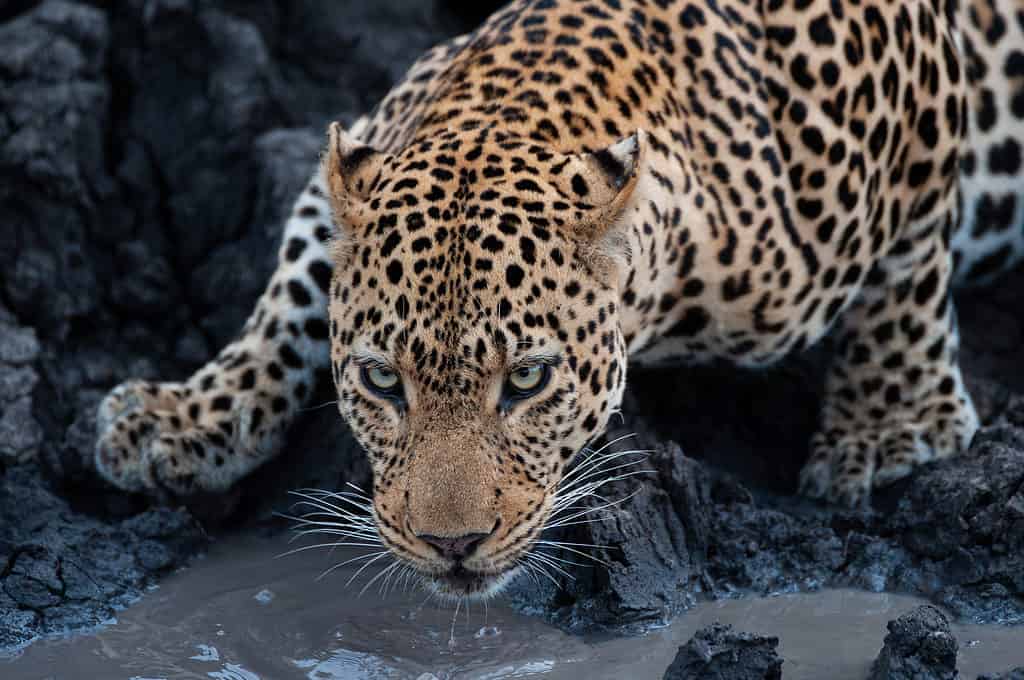
Leopards are one of the main predators of gazelles
©Rudi Hulshof/Shutterstock.com
The answer to this question is long because the gazelle is a major source of nutrients to huge predators, even though the antelope stands less than four feet tall. Some of the main predators of this animal include cheetahs, leopards, crocodiles, jackals, lions, hyenas, and wild dogs. They are sometimes hunted by humans as well, which is one of the main reasons for their dwindling numbers.
What Does the Gazelle Eat?
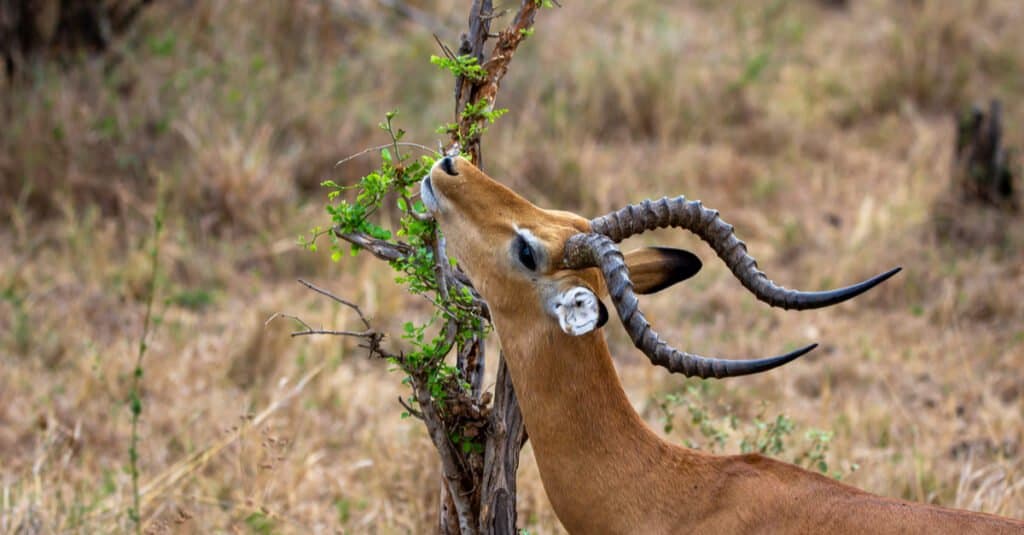
Gazelles are herbivores by nature and feed on shoots, shrubs, and leaves in their environment
©Benas Bakevicius/Shutterstock.com
Gazelles are not hunters. Their entire diet consists of plants that are found in their typical habitat. The only exception in their diet is when a gazelle is a baby (a.k.a. a fawn), during which time it drinks its mother’s milk.
Reproduction and Life Cycle
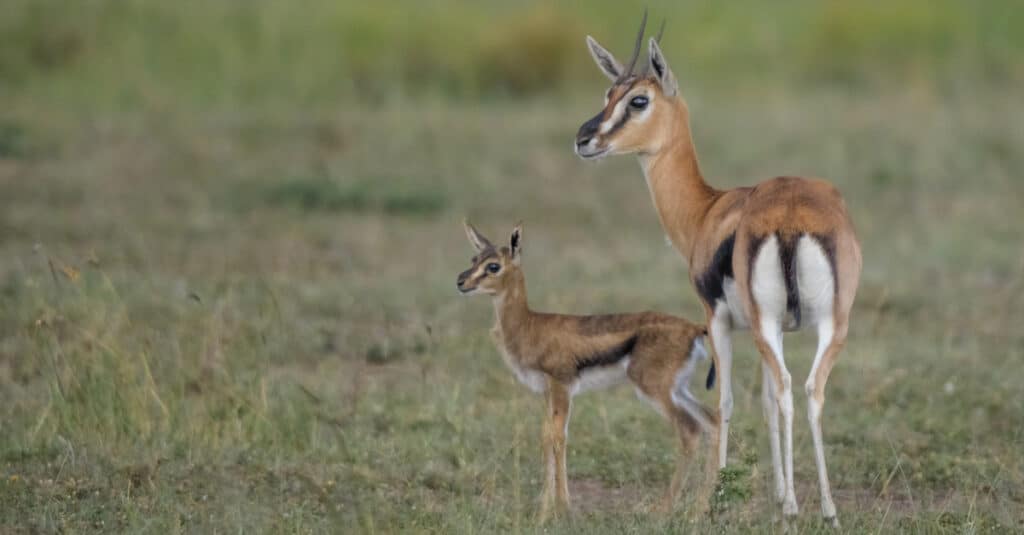
Newborn gazelles are weaned at four or five months
©iStock.com/Tobie Oosthuizen
When the male and the female gazelles are ready to mate, the ritual starts off with the male as he lowers his head and neck, stretching them. He follows closely behind the female, marching and prancing to get her attention. The average pregnancy for a gazelle baby is six months, though the female may give birth to up to two fawns at a time.
By the time the baby, which is called a fawn, is 20 minutes old, they can stand and nurse. The average birth weight of a newborn fawn is 10% to 12% of its mother’s weight.
Since they are an easy target for identification by predators, the mother conceals them in areas of tall grass. These babies have to stay with their mothers until they are weaned, which takes about four to five months. Females reach sexual maturity by nine months old while males take 18 months. The average lifespan of a gazelle is 10-15 years old.
Population
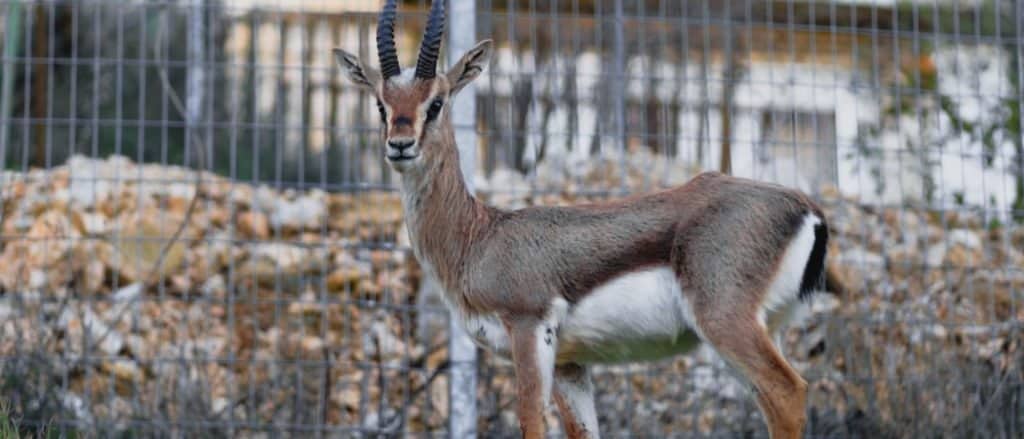
In spite of efforts made to restore the Dama species, numbers remain low
©yosefus/Shutterstock.com
Certain species of gazelle are critically endangered. The Dama is one such example, with less than 400 individuals in the wild.
The NGO Sahara Conservation Fund has worked to restore the population of the species in Africa through capturing them for reproduction, but numbers still remain low.
Species
- Arabian gazelle
- Arabian sand gazelle
- Chinkara
- Cuvier’s gazelle
- Dama gazelle
- Dorcas gazelle
- Erlanger’s gazelle
- Goitered gazelle
- Grant’s gazelle
- Mongala gazelle
- Mountain gazelle
- Red gazelle
- Red-fronted gazelle
- Rhim gazelle
- Soemmerring’s gazelle
- Speke’s gazelle
- Thompson’s gazelle
Gazelle FAQs (Frequently Asked Questions)
What is a gazelle?
A gazelle is part of the antelope family of mammals. They often have curved horns (though certain species like the Thomson’s gazelle and the Addra gazelle do not), paired with yellowish-brown fur along with the majority of their body with the exception of their belly (which is white). It is most often found in Africa and Asia. One of the most well-known facts about gazelles is that they have incredible speed.
How fast can a gazelle run?
On average, gazelles can run at a speed of 60 mph in short bursts. Longer runs typically are at a speed of 30 mph. Gazelle animals must be fast to outrun predators like lions and leopards.
What does a gazelle look like?
Gazelles have long horns, though there are some species with straight horns and others with curved horns. They have a yellowish-brown coat, sometimes separating the white belly with a bold streak of black fur (which is common for the Addra gazelle and the Thomson’s gazelle).
What is a female gazelle called?
A female gazelle is called a cow.
Can gazelles be pets?
While it is possible to keep a gazelle as a pet, it is best to let them live in the wild where they belong. They don’t make good pets as they require a habitat of substantial size to accommodate them. Most areas have deemed their use as a pet to be illegal.
What is a gazelle known for?
The gazelle animal is known for its great speed. As mentioned above, these animals can reach a speed of up to 60 mph, which is their main defense against predators.
Are gazelles smart?
Yes. Gazelles are incredibly smart, adapting to their surroundings with ease.
What are the key differences between antelopes and gazelles?
The key differences between antelopes and gazelles are appearance, stotting, habitat, speed, and lifespan.
What are the differences between an impala and a gazelle?
The main difference between a gazelle and an impala is that gazelles are a group of related antelope, while impalas are antelopes but don’t belong to the large taxonomic group known as gazelles.
Read about the other differences here!
Thank you for reading! Have some feedback for us? Contact the AZ Animals editorial team.
Sources
- OxfordLanguages / Accessed December 20, 2021
- Research Maniancs / Accessed December 20, 2021
- Animals Network / Accessed December 20, 2021
- ITIS / Accessed December 20, 2021
- Britannica / Accessed December 20, 2021
- DKfindout! / Accessed December 20, 2021
- ultimateungulate.com / Accessed December 20, 2021
- Squaw Mountain Ranch / Accessed December 20, 2021
- Sahara Conservation / Accessed December 20, 2021
- LIVESCIENCE / Accessed December 20, 2021
- Sciencing / Accessed December 20, 2021


















